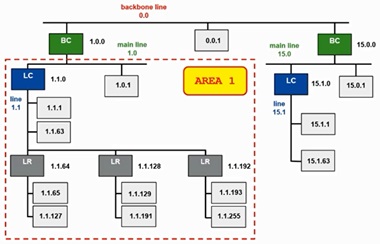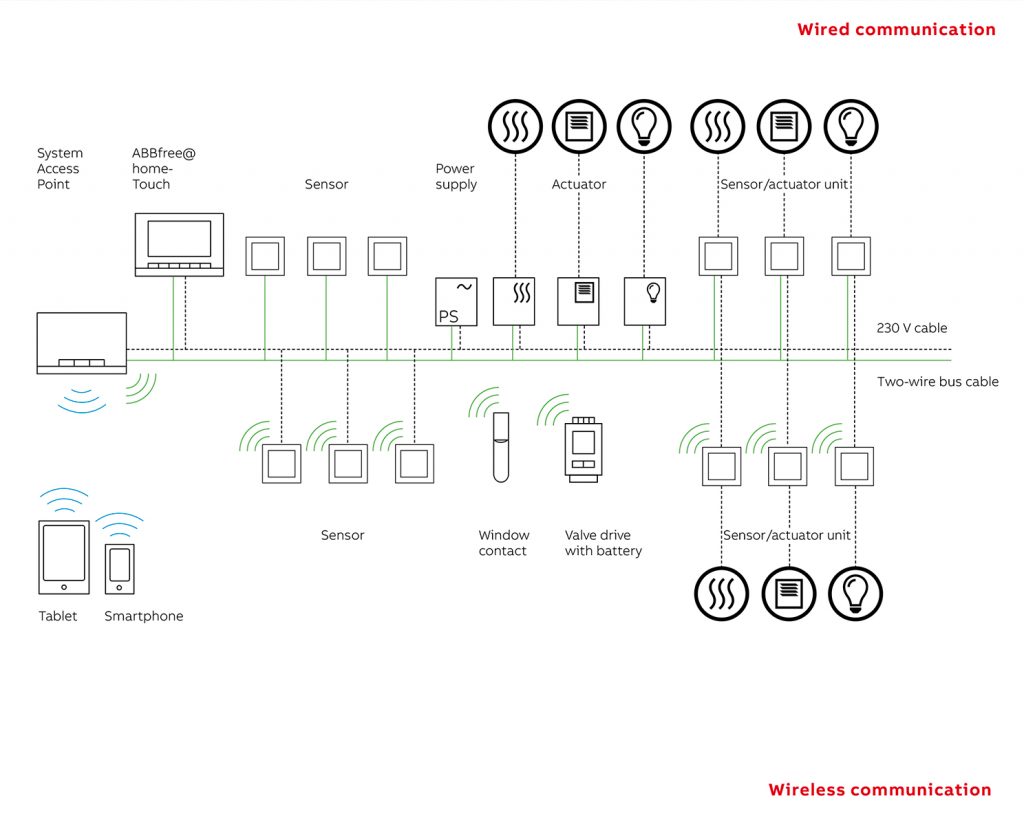device capacity in KNX smart home
1.7.1. Segment in KNX smart home
By definition in KNX smart home, a segment is any equipment being electrically connected together.
In this case a segment is a collection of TP1 devices that are electrically connected together.
In order to set up a TP1 segment a PSU and a TP1 choke is required.
TP1-64 vs. TP1-256 devices in knx
The maximum capacity (= number of devices that can be connected) of a TP1 segment is time related, i.e. when was the installation realized:
- Until end of 2018
- only TP1-64 devices could be used
- ’64’ simply means that maximum 64 devices of this type can be connected together
- As of 2019
- both TP1-64 and TP1-256 devices can be used
- TP1-64 and TP1-256 devices shall however not be mixed with one segment
- in case of TP1-64: maximum 64 devices of this type can be connected together
- in case of TP1-256: maximum 256 devices of this type can be connected together
Line in KNX smart home
A TP1 line consists out of maximum 4 TP1 segments.
In case more than one segment is required:
- one line repeater per extra segment is required
- one TP1 choke per extra segment is required
Couplers vs. (regular) devices
In order the calculate the line capacity for devices, the capacity taken by couplers and repeaters needs to be taken into account.
TP1-64 vs. TP1-256 devices
Since November 2017 also TP1-256 devices can be used within a TP1 segment, i.e. if a TP1 segment consists out of TP1-256 devices then no repeaters are required in order to reach the maximum capacity of a line.
Example 1 – only use TP1-64 devices:
To set up such a full ranged TP1 line, its first TP1 line segment need to be connected to 3 additional TP1 line segments. The 3 additional TP1 line segments are connected to the first TP1 line segment via 3 TP1/TP1 couplers. The primary side of all 3 TP1/TP1 couplers need to be connected to the first TP1 line segment. This mean that the 3 additional TP1 line segments are put in parallel, it is not allowed to put them in cascade.
Maximum capacity: segment 1 + segment 2 + segment 3 + segment 4
The capacity taken by the 3 TP1/TP1 couplers from the line (primary side + secondary side) is 3 * 2 = 6 devices.
This brings the maximum capacity of such a TP1 line to: (4 x 64) – 6 = 250 devices.
Example 2 – only use TP1-256 devices:
To set up such a full ranged TP1 line, only one TP1 line is required.
Maximum capacity: segment 1
No capacity is taken by TP1/TP1 couplers.
This brings the maximum capacity of such a TP1 line to: 256 devices.
Area in KNX smart home
TP1 lines can be extended into TP1 areas. Maximum 15 TP1 lines can be combined into one TP1 area. The base for a TP1 area is its main line. A TP1 area main line is limited to one TP1 line segment, which shall NOT be extended by means of TP1/TP1 couplers. In order to connect a TP1 line to a TP1 area main line, a TP1/TP1 coupler is to be used. The TP1 area main line is to be connected to the primary side of this TP1/TP1 coupler, which in this context is called a ‘Line Coupler’. The TP1 lines that are connected to the secondary sides of the TP1/TP1 coupler are not limited to one TP1 line segment.
Area capacity = [capacity main line] + [capacity line] x 15
- the capacity taken by the 15 TP1/TP1 couplers from the main line (primary side) is 15 x 1 = 15 devices
- per TP line:
- the capacity taken by the TP1/TP1 coupler for the connection with the main line (secondary side) is 1 device
- the capacity taken by the 3 TP1/TP1 couplers from the line (primary side + secondary side) is 3 x 2 = 6 devices
This brings the total capacity of an TP1 area to: [ 64 – 15 ] + [ (4 x 64) – 1 – 6 ] x 15 = 3784 devices.
TP1-256 devices
As of 2019 also TP1-256 devices can be used within a TP1 segment. If only TP1-256 devices are used then the area capacity calculation is a bit different:
Area capacity = [capacity main line] + [capacity line] x 15
- the capacity taken by the 15 TP1/TP1 couplers from the main line (primary side) is 15 x 1 = 15 devices
- per TP line: the capacity taken by the TP1/TP1 coupler for the connection with the main line (secondary side) is 1 device
This brings the total capacity of such an TP1 area to: [ 256 – 15 ] + [ 256 – 1 ] x 15 = 4066 devices.
Network in KNX smart home
In order to reach the full capacity of a TP1 network, areas can be connected together via a TP1 backbone line. The TP1 backbone line is limited to one TP1 segment, which shall NOT be extended by means of TP1/TP1 couplers. In order to connect a TP1 area to the TP1 backbone line, a TP1/TP1 coupler is to be used, which in this context is called a ‘Backbone Coupler’. The TP1 area main line is to be connected to the secondary side of this TP1/TP1 coupler.
Network capacity: [capacity backbone line] + [capacity area main line] x 15 + [capacity line] x 15 x 15
- the capacity taken by the 15 TP1/TP1 couplers from the backbone line (primary side) is 15 x 1 = 15 devices
- per TP1 area:
- the capacity taken by the TP1/TP1 coupler for the connection with the backbone line (secondary side) is 1 device
- the capacity taken by the 15 TP1/TP1 couplers from the main line (primary side) is 15 x 1 = 15 devices
- per TP1 area and per TP1 line:
- the capacity taken by the TP1/TP1 coupler for the connection with the main line (secondary side) is 1 device
- the capacity taken by the 3 TP1/TP1 coupler from the line (primary side + secondary side) is 3 x 2 = 6 devices
This brings the total capacity of a TP1 network to: [ 64 – 15 ] + [ 64 – 1 – 15 ] x 15 + [ (4 x 64) – 1 – 6 ] x 15 x 15 = 56794 devices.
Area 0 in KNX smart home
In order to be complete, it needs to be stated that the backbone line is also the main line of area 0. This means that in total maximum 30 TP1/TP1 couplers can be connected to the backbone line.
This brings the total capacity of a TP1 network to: [ 64 – 30 ] + [ 64 – 1 – 15 ] x 15 + [ (4 x 64) – 1 – 6 ] x 15 x 16 = 60514 devices.
Check
This calculation can also be reversed, total capacity = capacity of all lines + capacity of all main lines (the backbone line is also the main line of area 0) – capacity taken by all Backbone Couplers, Line Couplers and Line Repeaters: [16 x 15 x 256] + [16 x 64] – [ (15 x 2) + (16 x 15 x 2) + (16 x 15 x 3 x 2) ] = 60514 devices.
TP1-256 devices
As of 2019 also TP1-256 devices can be used within a TP1 segment. If only TP1-256 devices are used then the network capacity calculation is a bit different:
The total capacity of such a network = capacity of all lines + capacity of all main lines – capacity taken by the Backbone Couplers and Line Couplers: [16 x 15 x 256] + [16 x 256] – [ (15 x 2) + (16 x 15 x 2) ] = 65026 devices.














